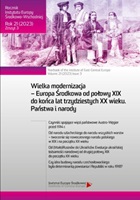Między traumą Trianon a integralnością Korony św. Stefana. Koncepcje i próby odbudowy Wielkich Węgier 1920-1947
Between the Trauma of Trianon and the Integrity of the Crown of St. Stefan. Concepts and attempts to rebuild Great Hungary 1920-1947
Author(s): Arkadiusz AdamczykSubject(s): Cultural history, Political history, Social history, Interwar Period (1920 - 1939), WW II and following years (1940 - 1949)
Published by: Instytut Europy Środkowej
Keywords: Trianon; Greater Hungary; Danube Federation; Vienna Awards; Peace of Paris (1947);
Summary/Abstract: The goal of the article is to undertake a cause and effect analysis of political events and to present the effects of the Treaty of Trianon as factors significantly influencing Hungarian efforts to preserve the integrity of the Holy Crown. Stefan. The analysis of the achievements of historiography leads to the conclusion that finding a way to connect the “lost lands” with the Kingdom was supposed to be an antidote to political, social and economic problems resulting from territorial losses. Opportunities to implement the idea of Greater Hungary until the mid-1930s were seen in federal plans integrating state organisms located along the Danube. It is not possible to implement the plans drawn up, e.g. by Oszkár Jászi, Elmér Hantos, Gusztáv Gratz and Miklós Makáy, as well as the deepening economic difficulties, were to cause that even at the ideological level the Hungarians were to abandon all attempts at a federation. Hopes of crossing out Trianon would find their outlet in alliances with countries striving to revise the treaties concluded after the First World War. The relationship with the Third Reich allowed for a short-term recovery of fragments of Slovakia, Transylvania and Transcarpathian Ruthenia and gave hope for a return to the pre-1914 borders. However, these acquisitions proved to be unsustainable. The conclusion of peace in Paris in 1947 closed the way for the restitution of Greater Hungary. Although nowadays both the concepts of the Danube federation and the postulates of territorial changes have only the value of a historical argument, they do not mean the abandonment of the idea of Nagy-Magyarország. This concept has now only changed its formula in the direction of connecting Hungarians living in neighboring countries with the Motherland.
Journal: Rocznik Instytutu Europy Środkowo-Wschodniej
- Issue Year: 21/2023
- Issue No: 3
- Page Range: 193-213
- Page Count: 21
- Language: Polish

